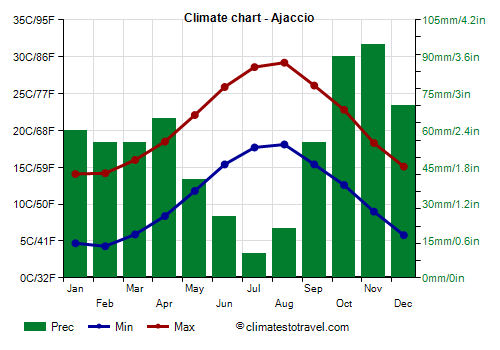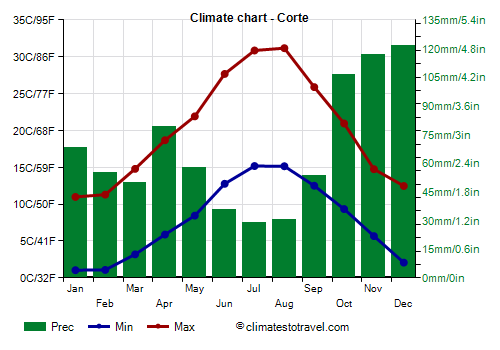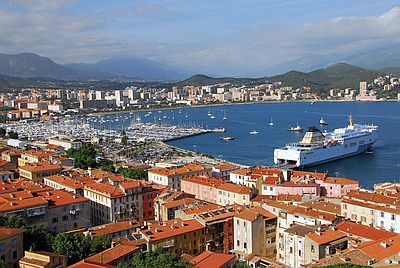Select units of measurement for the temperature and rainfall tables (metric or imperial).
Average weather, temperature, rainfall, sunshine hours
The climate of Corsica is
Mediterranean on the coast, with mild, rainy winters and warm, sunny summers, while in inland areas it gradually becomes colder with increasing altitude. In fact, the interior of the island is largely mountainous; the highest peak is Monte Cinto, 2,706 meters (8,878 feet) high. At high altitudes, snowfalls can occur in winter and early spring, and sometimes, it can snow even in the first half of May.
In the major cities that are located on the coast, like Ajaccio, Calvi, Bastia, Bonifacio, Porto Vecchio, the climate is similar, ie Mediterranean.

In
Ajaccio, the largest city, located on the west coast, the average temperature ranges from around 9 °C (48 °F) in February to 23.5 °C (74.5 °F) in August. Here are the average temperatures.
Ajaccio - Average temperatures (1991-2020) |
| Month | Min | Max | Mean |
|---|
| January | 4.7 | 14.1 | 9.4 |
|---|
| February | 4.3 | 14.2 | 9.2 |
|---|
| March | 5.9 | 16 | 11 |
|---|
| April | 8.4 | 18.5 | 13.4 |
|---|
| May | 11.8 | 22.1 | 17 |
|---|
| June | 15.4 | 25.9 | 20.6 |
|---|
| July | 17.7 | 28.6 | 23.2 |
|---|
| August | 18.1 | 29.2 | 23.6 |
|---|
| September | 15.4 | 26.1 | 20.8 |
|---|
| October | 12.6 | 22.8 | 17.7 |
|---|
| November | 9 | 18.3 | 13.6 |
|---|
| December | 5.8 | 15.1 | 10.4 |
|---|
| Year | 10.8 | 20.9 | 15.85 |
|---|

In Sartena, which is 350 meters (1,150 ft) above sea level, and even more in
Corte, which sits at 400 meters (1,300 feet) and in the interior of the island, it is instead a bit colder in winter, while it can get hotter during the day in summer, with some more thunderstorms, but also a bit cooler at night. Here are the average temperatures in Corte.
Corte - Average temperatures (2011-2019) |
| Month | Min | Max | Mean |
|---|
| January | 1.1 | 11 | 6 |
|---|
| February | 1.1 | 11.3 | 6.2 |
|---|
| March | 3.2 | 14.8 | 9 |
|---|
| April | 5.9 | 18.7 | 12.3 |
|---|
| May | 8.5 | 21.9 | 15.2 |
|---|
| June | 12.8 | 27.7 | 20.2 |
|---|
| July | 15.2 | 30.9 | 23 |
|---|
| August | 15.2 | 31.2 | 23.2 |
|---|
| September | 12.5 | 25.9 | 19.2 |
|---|
| October | 9.3 | 21 | 15.2 |
|---|
| November | 5.7 | 14.8 | 10.2 |
|---|
| December | 2.1 | 12.5 | 7.3 |
|---|
| Year | 7.7 | 20.2 | 13.9 |
|---|
The island is pretty
windy because it can be affected by the
Maestrale (or Mistral), the wind coming from the Rhone Valley, which blows in gusts, presenting itself here as a west wind. On the other hand, the
Libeccio, the even more frequent wind which blows from the south-west, is moist and is usually followed by bad weather conditions. In winter, the
Tramontana can also blow from the north. In summer, however, the breezes blow.
The windiest areas are the Cap Corse (the finger-shaped peninsula in the north), the west coast, and in particular the Strait of Bonifacio to the south (where the sea is often rough), and the mountains.
On the mountain slopes of the interior,
precipitation is more abundant, and summer thunderstorms are more likely; for this reason, some inland areas are very rainy and covered with forests. On the other hand, along the coast, annual precipitation does not exceed 700 millimeters (27.5 inches), and follows the Mediterranean pattern, with a maximum from October to February, a gradual decrease in spring, and a minimum in summer.
Here is the average rainfall in Ajaccio.
Ajaccio - Average precipitation| Month | Days |
|---|
| January | 60 | 8 |
|---|
| February | 55 | 7 |
|---|
| March | 55 | 8 |
|---|
| April | 65 | 8 |
|---|
| May | 40 | 6 |
|---|
| June | 25 | 3 |
|---|
| July | 10 | 1 |
|---|
| August | 20 | 2 |
|---|
| September | 55 | 5 |
|---|
| October | 90 | 8 |
|---|
| November | 95 | 8 |
|---|
| December | 70 | 8 |
|---|
| Year | 640 | 72 |
|---|
The seasons
Winter, from December to February, is mild and rainy on the coast, where the average temperature in January and February is about 8/9 °C (46/48 °F). In the mountains, where ski resorts are found, winter is cold, with quite frequent snowfalls. The wind blows frequently.
Sometimes, the wind blowing from the Rhone Valley is colder than usual because the air mass is of Polar or Siberian origin. In these cases, there may be snowfalls even in the plains, especially in the northern part of the island. On the plains and the coasts, light frosts may occur during cold waves: generally, the temperature does not drop below -2/-3 °C (27/28 °F), although the records are lower: -8 °C (18 °F) in Ajaccio, set in February 1986.
Spring is initially cool and unstable in March and April, while it becomes gradually milder and sunnier as the weeks pass, and it becomes generally pleasant by May.
Summer, from June to August, is warm to hot and sunny along the coasts, while in inland areas, it becomes progressively cooler with increasing altitude, and there is also a higher chance of afternoon thunderstorms. These thunderstorms can sometimes reach the coasts.
On the coasts, the heat is usually acceptable, since it is a bit moist but also tempered by the breeze. Sometimes, however, there may be waves of African heat, usually of short duration, with peaks around 38/40 °C (100/104 °F).
Autumn is initially mild or pleasantly warm, and gradually becomes cooler; it is also quite rainy. The first disturbances occur in September, and become more frequent in October. November is typically a cloudy and rainy month, as normally happens also in north-central Italy.

The amount of
sunshine in Corsica is very good in summer, especially along the coasts, when clear skies prevail, while it's not high from November to February, when Atlantic depressions frequently pass over the island. However, sunny periods can occur even in winter. Ajaccio receives around 2,750 hours of sunshine per year.
Ajaccio - Sunshine hours| Month | Average | Total |
|---|
| January | 4.5 | 135 |
|---|
| February | 5.5 | 155 |
|---|
| March | 7 | 210 |
|---|
| April | 7.5 | 225 |
|---|
| May | 9.5 | 285 |
|---|
| June | 11 | 325 |
|---|
| July | 12 | 370 |
|---|
| August | 11 | 335 |
|---|
| September | 8.5 | 260 |
|---|
| October | 6.5 | 200 |
|---|
| November | 4.5 | 135 |
|---|
| December | 3.5 | 115 |
|---|
| Year | 7.6 | 2755 |
|---|
Corsica is the French region where the
sea reaches the highest temperature, ie 25 °C (77 °F) in August, while it is still cool in June, around 21 °C (70 °F). In July and September, it is around 23/23.5 °C (73.5/74.5 °F).
Ajaccio - Sea temperature| Month |
|---|
| January | 14 |
|---|
| February | 13.5 |
|---|
| March | 14 |
|---|
| April | 15 |
|---|
| May | 17.5 |
|---|
| June | 21 |
|---|
| July | 23.5 |
|---|
| August | 25 |
|---|
| September | 23 |
|---|
| October | 21 |
|---|
| November | 18"> |
|---|
| December | 15.5 |
|---|
| Year | 18.4 |
|---|
Best Time
If you want to visit
cities, you can choose the period from mid-April to mid-June, and the month of September, since it can be very hot in summer, though it rarely happens.
If you plan to go hiking in the
mountains, you can go from June to September.
The best months for a
beach holiday are July and August. In June and September, you can go, but it can sometimes be a bit cool in the evening, or it can rain, and in June, as mentioned, the sea is still cool. For cool evenings and windy days, you can bring a sweatshirt.
In summer, in inland areas, where thunderstorms can break out, even if the weather is fine in the morning, care must be taken to lightning (therefore, it's better not to take shelter in the forests or under the trees), as well as to the possible sudden swelling of streams during heavy rains.